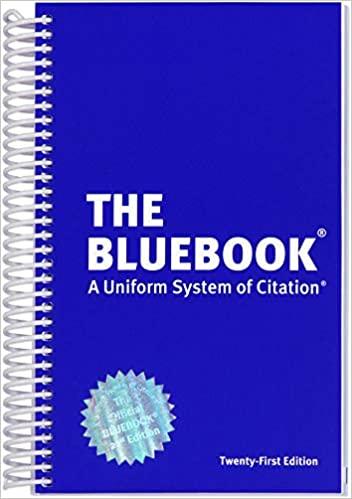Question
Professor Question: (Key Terms & Concepts)Torts, Negligence & Strict Liability (SET 3) (PLEASE READ)(RESPONSE OPTIONAL) Class, feel free to choose any 3 of the Key
Professor Question: (Key Terms & Concepts)Torts, Negligence & Strict Liability (SET 3) (PLEASE READ)(RESPONSE OPTIONAL)
Class, feel free to choose any 3 of the "Key Terms and Concepts" below to discuss related to:Torts, Negligence & Strict Liability. Choose any that you find most interesting.
WRITTEN ANALYSIS: Provide a written analysis of the concept selected below, explaining and expanding on the important role that the term or concept plays in the field of law (in your opinion and supported by textbook or other analysis) How is it used or applied to promote justice or regulate commercial activity? Do you
YOU BE THE JUDGE:Can you provide any legal case that involved one of these issues related tothis legal issue? What was the Issue Rule Analysis and Conclusion (IRAC) by the court in the case?. Do you agree with the decision in the case? Why or why not?
RELATED ARTICLE ANALYSIS:Can you provide any journal or article related to the legal concepts you chose? What is interesting about what you read regarding the legal issue or concept?
Enjoy the discussion,
Prof. Elliott
NOTE: Responses must be based upon research from the course textbook and other official academic sources. Please feel free to include the page #'s referenced in the course textbook. (include websites as a supplement to these other sources)
- Invasion of the right to privacyA tort that constitutes the violation of a person's right to live his or her life without being subjected to unwarranted and undesired publicity.
- Liability without faultStrict liability is liability without fault.
- LibelA false statement that appears in a letter, newspaper, magazine, book, photograph, movie, video, etc.
- Malicious prosecutionA lawsuit in which the original defendant sues the original plaintiff. In the second lawsuit, the defendant becomes the plaintiff and vice versa.
- Merchant protection statute (shopkeeper's privilege)Statutes that allow merchants to stop, detain, and investigate suspected shoplifters without being held liable for false imprisonment if (1) there are reasonable grounds for the suspicion, (2) suspects are detained for only a reasonable time, and (3) investigations are conducted in a reasonable manner.
- Misappropriation of the right to publicity (tort of appropriation)An attempt by another person to appropriate a living person's name or identity for commercial purposes.
- Negligenceper seA tort in which the violation of a statute or an ordinance constitutes a breach of the duty of care.
- Negligent infliction of emotional distressA tort that permits a person to recover for emotional distress caused by the defendant's negligent conduct.
- New York Times Co. v. SullivanThe U.S. Supreme Court held that public officials cannot recover for defamation unless they can prove that the defendant acted with "actual malice."
- Palsgraf v. The Long Island Railroad CompanyThe landmark case establishing the doctrine of proximate cause.
- Partial comparative negligenceProvides that a plaintiff must be less than fifty (50) percent responsible for causing his or her own injuries to recover under comparative negligence.
- Product liabilityTheory of recovery available to a consumer who is injured by a defective product.
- Professional malpracticeThe liability of a professional who breaches his or her duty of care.
- Proximate cause (legal cause)A point along a chain of events caused by a negligent party after which this party is no longer legally responsible for the consequences of his or her actions.
- Public figureIndividuals in our society who are commonly known. Examples include movie stars, sports personalities, and other celebrities. Public figures cannot recover for defamation unless they can prove that the defendant acted with "actual malice."
- Punitive damagesMonetary damages awarded to punish a defendant who either intentionally or recklessly injured the plaintiff.
- Reasonable person standardA test used to determine whether a defendant owes a duty of care. This test measures the defendant's conduct against how an objective, careful, and conscientious person would have acted in the same circumstances.
- Reasonable professional standardHow an objective, careful, and conscientious equivalent professional would have acted in the same circumstances. In a negligence action, the defendant professional's conduct is measured against that standard.
- Res ipsa loquiturA tort in which the presumption of negligence arises because (1) the defendant was in exclusive control of the situation, and (2) the plaintiff would not have suffered injury but for someone's negligence.
- ScienterIntent or knowledge of wrongdoing. The offending party has knowledge of the wrongfulness of an act prior to committing it.
- SlanderAn oral defamatory statement.
- Statute of reposeA statute that limits the seller's liability to a certain number of years from the date when the product was first sold.
- Strict liabilityA tort doctrine that makes manufacturers, distributors, wholesalers, retailers, and others in the chain of distribution of a defective product liable for the damages caused by the defect, regardless of fault.
- Supervening eventAn alteration or a modification of a product by a party in the chain of distribution that absolves all prior sellers from strict liability.
- TortA wrong. There are three categories of torts: (1) intentional torts; (2) unintentional torts (negligence); and (3) strict liability.
- Unintentional tort (negligence)A doctrine that says a person is liable for harm that is the foreseeable consequence of his or her actions.
Step by Step Solution
There are 3 Steps involved in it
Step: 1

Get Instant Access to Expert-Tailored Solutions
See step-by-step solutions with expert insights and AI powered tools for academic success
Step: 2

Step: 3

Ace Your Homework with AI
Get the answers you need in no time with our AI-driven, step-by-step assistance
Get Started


